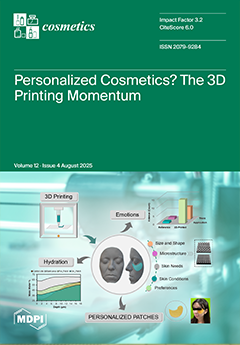Background: Blackberry seed oil (BSO), obtained from
Rubus spp. Xavante cultivar via supercritical CO
2 extraction, contains bioactive lipids and antioxidants, but its cosmetic application is limited by poor solubility and stability. Nanoencapsulation with poly(ε-caprolactone) (PCL) can overcome these limitations.
Methods: BSO was
[...] Read more.
Background: Blackberry seed oil (BSO), obtained from
Rubus spp. Xavante cultivar via supercritical CO
2 extraction, contains bioactive lipids and antioxidants, but its cosmetic application is limited by poor solubility and stability. Nanoencapsulation with poly(ε-caprolactone) (PCL) can overcome these limitations.
Methods: BSO was characterized by Ultra-High-Performance Liquid Chromatography coupled with electrospray ionization quadrupole time-of-flight mass spectrometry and incorporated into PCL nanocapsules (NCBSO) using the preformed polymer deposition method. Physicochemical properties, stability (at 4 °C, room temperature, and 37 °C for 90 days), cytotoxicity, and collagen production were assessed in human fibroblasts. Additionally, a predictive in silico analysis using PASS Online, Molinspiration, and SEA platforms was performed to identify the bioactivities of major BSO compounds related to collagen synthesis, antioxidant potential, and anti-aging effects.
Results: NCBSO showed a nanometric size of ~267 nm, low polydispersity (PDI < 0.2), negative zeta potential (−28 mV), and spherical morphology confirmed by FE-SEM. The dispersion remained stable across all tested temperatures, preserving pH and colloidal properties. In particular, BSO and NCBSO at 100 µg.mL
−1 significantly enhanced in vitro collagen production by 170% and 200%, respectively, compared to untreated cells (
p < 0.01). Superior bioactivity was observed for NCBSO. The in silico results support the role of key compounds in promoting collagen biosynthesis and protecting skin structure. No cytotoxic effects were achieved.
Conclusions: The nanoencapsulation of BSO into PCL nanocapsules ensured formulation stability and potentiated collagen production. These findings support the potential of NCBSO as a promising candidate for future development as a collagen-boosting cosmeceutical.
Full article





